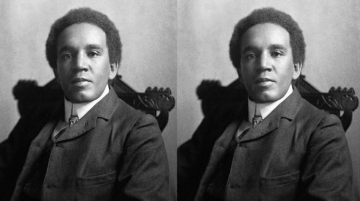Sudip Bose at The American Scholar:
 Coleridge-Taylor was deeply interested in both African and African-American melodies. A meeting with the American writer Paul Laurence Dunbar in 1896, for example, had let to a vocal work, African Romances, with the two of them deciding to put on a series of performances together. Another work, the Twenty-Four Negro Melodies for piano, was influenced by Dunbar’s work. “What Brahms has done for the Hungarian folk music,” Coleridge-Taylor wrote in the preface to the score, “Dvořák for the Bohemian, and Grieg for the Norwegian, I have tried to do for these Negro melodies.” But though the composer’s political consciousness had been informed by an abiding interest in pan-Africanism, though his explorations of his paternal ancestry had him briefly flirting with the idea of relocating to the United States, he primarily filtered the raw materials of black American and African music through a distinctly European sensibility, Brahms and Dvořák being his guiding lights. Coleridge-Taylor’s true métier was the realm of light English music, and as interest in that field diminished with the passing of the 20th century, with the decline of the amateur choruses that once would have taken up such repertoire, so too did an interest in his music. This was already true by 1912, the year the composer died from pneumonia, having collapsed at the West Croydon station, while waiting for a train.
Coleridge-Taylor was deeply interested in both African and African-American melodies. A meeting with the American writer Paul Laurence Dunbar in 1896, for example, had let to a vocal work, African Romances, with the two of them deciding to put on a series of performances together. Another work, the Twenty-Four Negro Melodies for piano, was influenced by Dunbar’s work. “What Brahms has done for the Hungarian folk music,” Coleridge-Taylor wrote in the preface to the score, “Dvořák for the Bohemian, and Grieg for the Norwegian, I have tried to do for these Negro melodies.” But though the composer’s political consciousness had been informed by an abiding interest in pan-Africanism, though his explorations of his paternal ancestry had him briefly flirting with the idea of relocating to the United States, he primarily filtered the raw materials of black American and African music through a distinctly European sensibility, Brahms and Dvořák being his guiding lights. Coleridge-Taylor’s true métier was the realm of light English music, and as interest in that field diminished with the passing of the 20th century, with the decline of the amateur choruses that once would have taken up such repertoire, so too did an interest in his music. This was already true by 1912, the year the composer died from pneumonia, having collapsed at the West Croydon station, while waiting for a train.
more here.
